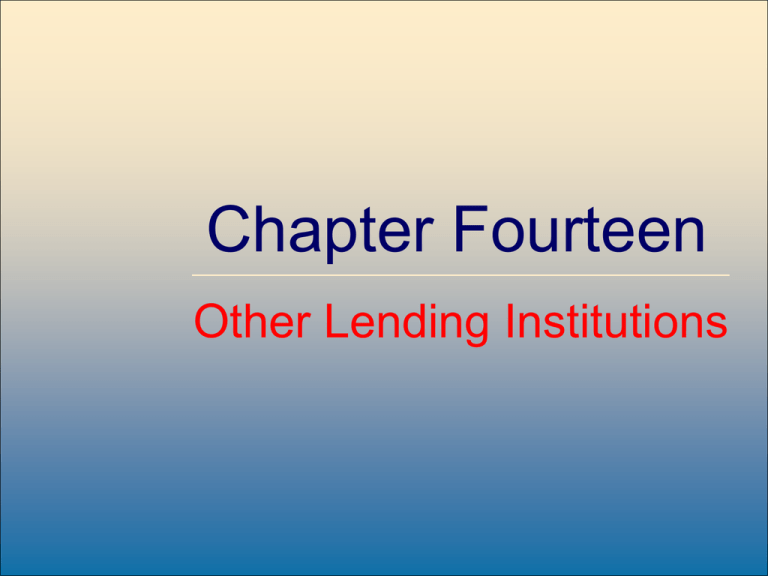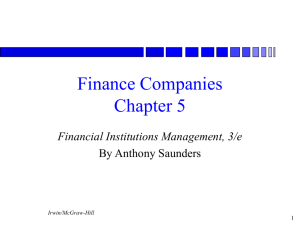
Chapter Fourteen
Other Lending Institutions
McGraw-Hill /Irwin
Copyright © 2007 by The McGraw-Hill Companies, Inc. All rights reserved.
Chapter Outline
1. Other categories
2. Savings institutions: Savings Associations and
Savings Banks
3. Credit union
4. C&L crisis
5. Finance Company
1. Overview: Other Lending Institutions
• Savings Associations (1,074 in 2004)
– concentrated primarily on residential mortgages
• Savings Banks (339 in 2004)
–
–
–
–
large concentration of residential mortgages
commercial loans
corporate bonds
corporate stock
• Credit Unions (9,210 in 2004)
– consumer loans funded with member deposits
• Finance Companies
– Make loans to individuals and businesses
McGraw-Hill /Irwin
Copyright © 2007 by The McGraw-Hill Companies, Inc. All rights reserved.
Composition of the Industry
Saving associations
(1, 074*) (SAIF**)
(TA = $1,123,981m)
Saving Institutions
* - Number of
institutions in 2004
** - Insurer
SAIF – the Savings
Association Insurance
Fund
BIF – the Bank
Insurance Fund
NCUSIF – the National
Credit Union Share
Insurance Fund
McGraw-Hill /Irwin
Residential mortgages
Individuals
Deposits
Residential mortgages
Savings Banks
(339*) (BIF**)
(TA = $508,614m)
Deposits
Commercial loans
Deposits
Credit Unions
(9,210*) (NCUSIF**)
(TA = $648,700m)
Individuals
Corporations
Consumer loans
Individuals
Deposits
Copyright © 2007 by The McGraw-Hill Companies, Inc. All rights reserved.
2. Savings Associations
• Historically referred to as savings and loan
(S&L) associations
• Assets concentrated in real estate loans
• Liabilities concentrated in retail CDs
• Can be either mutually owned or shareholder
owned
• Deposits insured by FDIC – SAIF
• Regulators: Office of Thrift Supervision (OTS)
Savings Banks
• Established as mutual organizations and largely
confined to the East Coast and New England states
• Deposits are insured by the FDIC under the Bank
Insurance Fund (BIF)
• Historically allowed greater freedom to diversify
into corporate bonds and stocks
• Rely more on deposits than savings associations
and have fewer borrowed funds
Real Estate Assets of Savings Associations
and Savings Banks (2004)
13%
3%
5%
49%
5%
Mortgage
Backed
Securities
Construction and
Land
Development
Commercial Real
Estate Loans
Multifamily
Residential
Other assets
25%
McGraw-Hill /Irwin
Family
Residential
Copyright © 2007 by The McGraw-Hill Companies, Inc. All rights reserved.
Regulators of Savings Institutions
• The Office of Thrift Supervision - established in 1989
under the FIRREA, charters and examines all federal
savings institutions and supervises the holding
companies of savings institutions
• The FDIC - oversees, manages SAIF and BIF
• SAIF - provides insurance coverage for savings
associations
• BIF - provides insurance coverage for savings banks
• Other regulators - state-chartered savings institutions
are regulated by state agencies
3. Credit Unions
• Are not-for-profit depository institutions mutually
organized and owned by their members (depositors)
• Funding almost totally from member deposits
• Tend to hold higher levels of equity than other
depository institutions
• Can be federally chartered and regulated by NCUA or
state chartered and regulated by the state
• Deposits insured by the NCUSIF
• Exempt from corporate taxes
• Growth is not the primary goal
McGraw-Hill /Irwin
Copyright © 2007 by The McGraw-Hill Companies, Inc. All rights reserved.
Composition of Credit Union Loan
Portfolio, 2004
17%
30%
22%
13%
6%
6%
McGraw-Hill /Irwin
6%
First Mortgage
Loans
Other Real Estate
Loans
Other Loans to
members
Credit Card
Loans
All other
Unsecured Loans
Used Vehicle
Loans
New Vehicle
Loans
Copyright © 2007 by The McGraw-Hill Companies, Inc. All rights reserved.
Composition of Credit Union Investment
Portfolio, 2004
18%
Corp Credit Union
Investments
Other Investments
8%
Bank and S&L
CDs
56%
16%
2%
McGraw-Hill /Irwin
U.S. Gov
Obligations
Fed Agency
Securities
Copyright © 2007 by The McGraw-Hill Companies, Inc. All rights reserved.
Composition of Credit Union Deposits,
2004
12%
Regular
Shares
36%
19%
CDs
Other
Deposits
IRAs and
Keogh
Accounts
Money Market
Shares
9%
1%
McGraw-Hill /Irwin
Share Drafts
23%
Copyright © 2007 by The McGraw-Hill Companies, Inc. All rights reserved.
4. S&L Crisis
• 1930s Basic Regulatory Structure put in
place.
–
–
–
–
S&Ls limited to fixed rate mortgage loans
Deposit Insurance with fixed premium
Deposits insured by FSLIC
Deposit rate ceilings (Regulation Q)
• 1970s - Fluctuating and increasing interest
rates lead to deposit outflows
S&L Crisis
• Initial response - Deregulation
– removed deposit rate ceilings
– lessened investment restrictions
– raised insurance ceiling to $100,000 from $40,000
• Record high interest rates in early 80s lead to
losses
– Many S&Ls economically insolvent
– FSLIC economically insolvent
S&L Crisis
• Next response - regulatory forbearance
– Allow insolvent S&Ls to continue in operation rather
than close them down
– FSLIC did not have sufficient funds to close
insolvent S&Ls and payoff depositors
– Hoped the problems would go away
S&L Crisis
• S&Ls attempt to “grow out of the problem”
– commercial real estate loans
– junk bonds
– brokered deposits
• Increased the moral hazard because an operating
but insolvent S&L, a zombie S&L, has nothing to
lose by taking on greater risk
• Zombie S&Ls attracted deposits away from healthy
S&L's by offering higher interest rates
• FSLIC fund was bankrupt by the end of 1986
S&L Crisis
• Next Response – re-regulation
(Financial Institutions Reform, Recovery, and
Enforcement Act, 1989)
– Zombie thrifts finally closed
– New supervisory agency (Office of Thrift
Supervision)
– Insurance moved to FDIC
– Higher capital standards
– Risk based capital and risk based deposit insurance
premiums
– Investment restrictions
5. Finance Company Functions
• Originated during the Depression when General
Electric Corp. created GE Capital Corp. to finance
appliance sales to cash-strapped customers
• In the late 1950’s, banks became more willing to make
installment loans so finance companies branched out
into leasing and leveraged buyouts
• Willing to lend to riskier borrowers
• Often are directly affiliated with manufacturing
• Limited regulation
McGraw-Hill /Irwin
Copyright © 2007 by The McGraw-Hill Companies, Inc. All rights reserved.
Three Major Types of Finance Companies
• Sales finance institutions
– finance companies specializing in loans to customers of a
particular retailer or manufacturer (e.g., Ford Motor Credit
and Sears Roebuck Acceptance Corp.)
• Personal credit institutions
– finance companies specializing in installment and other loans
to consumers (e.g., Household Finance Corp. and American
General Finance)
• Business credit institutions
– finance companies specializing in business loans, leasing, and
factoring (e.g., CIT Group and Heller Financial)
McGraw-Hill /Irwin
Copyright © 2007 by The McGraw-Hill Companies, Inc. All rights reserved.
Assets of U.S. Finance Companies
(September 30, 2004) ($Bn)
Accounts receivable gross ……… $1,354.7
Consumer …………………………. 462.6
Business …………………………… 598.3
Real estate …………………………. 293.8
Less reserves for unearned income …… (75.1)
Less reserves for losses ………………. (20.9)
Accounts receivable net ………………. 1,258.7
All other ………………………………. 487.1
Total Assets
McGraw-Hill /Irwin
$1,745.8
77.6%
26.5
34.3
16.8
(4.3)
(1.2)
72.1
27.9
100.0
Copyright © 2007 by The McGraw-Hill Companies, Inc. All rights reserved.
Liabilities of U.S. Finance Companies
(September 30, 2004) ($Bn)
Bank loans …………………………… $ 64.1
Commercial paper ……………………. 150.8
Debt due to parent ……………………. 112.3
Debt not elsewhere classified ………… 768.8
All other liabilities ……………………. 415.9
Capital, surplus, undivided profits ……. 233.9
3.7%
8.7
6.4
44.0
23.8
13.4
Total Liabilities
100.0
McGraw-Hill /Irwin
$1,745.8
Copyright © 2007 by The McGraw-Hill Companies, Inc. All rights reserved.
Balance Sheet
• Assets
– Business and consumer loans (called accounts
receivable) and real estate loans
• Liabilities and equity
– FCs cannot accept deposits, so they rely heavily
on issuing short-term commercial paper and
other debt instruments (longer-term notes and
bonds) to finance assets
McGraw-Hill /Irwin
Copyright © 2007 by The McGraw-Hill Companies, Inc. All rights reserved.
Finance Company Assets, 2004
30.1
32.2
Business Loans
Consumer Loans
Real Estate Loans
Other Assets
13.2
24.5
McGraw-Hill /Irwin
Copyright © 2007 by The McGraw-Hill Companies, Inc. All rights reserved.
Consumer Loans
• Motor vehicle loans and leases are the major type of
consumer loan (80.4% in 2001)
• Subprime lender - a finance company that lends to highrisk customers
• Loan sharks - subprime lenders that charge unfairly
exorbitant rates to desperate, subprime borrowers
• Other consumer loans (19.6% in 2001)
– personal cash loans
– mobile home loans
– loans for consumer goods
McGraw-Hill /Irwin
Copyright © 2007 by The McGraw-Hill Companies, Inc. All rights reserved.
Mortgages
• Residential and commercial mortgages have become a
major component of finance companies’ assets
• Often issued to riskier borrowers and charge a higher
interest rate for that risk
• Securitized mortgage assets: mortgages packaged and
used as assets backing secondary market securities
• Bad debt expense and administrative costs of home
equity loans are lower and have become a very
attractive product for finance companies
McGraw-Hill /Irwin
Copyright © 2007 by The McGraw-Hill Companies, Inc. All rights reserved.
Business Loans
• Represent the largest portion of the loan portfolio
• Several advantages over commercial banks offered to
small-business customers
– they are not subject to regulations that restrict the type of
products and services
– do not accept deposits so no bank regulators
– have substantial industry and product expertise
– more willing to accept risky customers
– generally have lower overheads
• Business lending also includes equipment loans or
leasing, purchase accounts receivable, small farm loans,
wholesale loans/leases of mobile homes
McGraw-Hill /Irwin
Copyright © 2007 by The McGraw-Hill Companies, Inc. All rights reserved.




